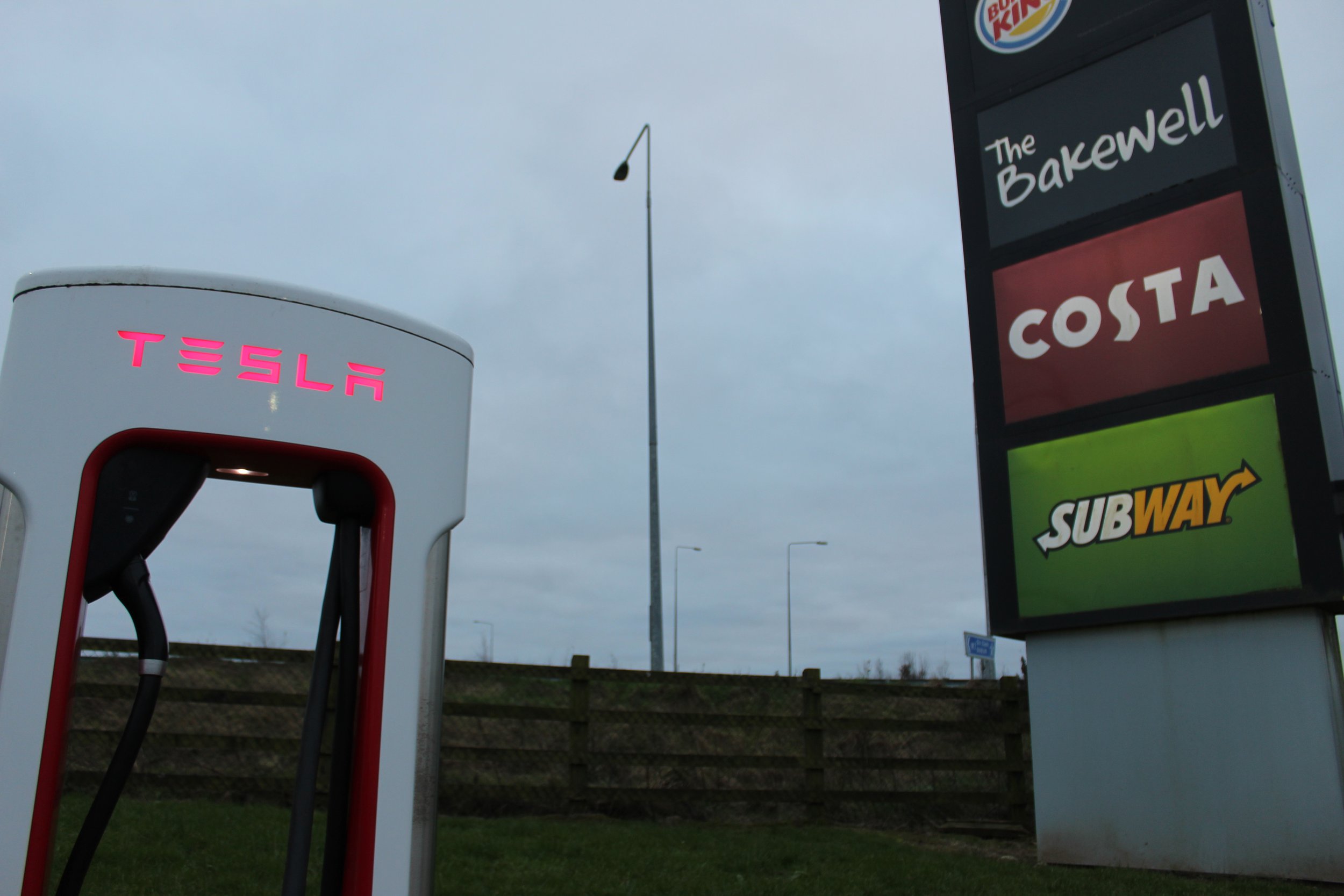The Growth of Electric Vehicles and our Tesla Road Trip to Cloudforest One
According to the SEAI, at the end of 2021 – there were 45,000 electric vehicles in Ireland. As well as this, new electric cars registrations has tripled in the last three years (8,646 in 2021 compared to 4,013 in 2020 and 3,444 in 2019). In January 2022, new electric car registrations reached their highest month on record with 2,714 registered in January 2022, which is an +178% increase from January 2021. This move towards electric vehicles has been in the pipeline for many years as individuals & businesses have sought ways to reduce their carbon footprint in the face of the major climate crisis we face.
This move has also been extensively pushed by the Irish government as they seek to bring down national emissions, to reach the impending net-zero target set out in legislation (The Climate Action Plan). More recently, ballooning fuel prices have meant that many people who before hadn’t even considered purchasing an electric vehicle are now seriously looking at the possibility.
There are two main types of Electric vehicles, which each have their own advantages & disadvantages:
Hybrid Vehicles are vehicles that use a combination of electric power & fossil fuels, like petrol & diesel. These hybrid vehicles can be separated into two categories; Plug-in and Non-Plug-in.
Non-Plug-in Hybrid vehicles (or simply, Hybrids) are powered by both an electric motor and an internal combustion engine (ICE). The electric battery of most hybrids is powered by the ICE and/or the motion of the wheels.
Plug-in Hybrid Electric Vehicles (PHEVs) are similar to Non-Plug-in Hybrid Electric Vehicles, in that, they are powered by both an electric motor and an internal combustion engine (ICE). As well as that, their batteries are charged by the motion of their wheels and ICE. However, where Plug-in Hybrid Electric Vehicles differ is that they can be plugged into a charging point which provides cheaper and cleaner electric energy.
Battery Electric Vehicles on the other hand are vehicles that solely use a battery as a means of energy storage for the propulsion of the vehicle. This means there is no need for fossil fuels like petrol/diesel. It is driven by an electric motor powered by battery energy storage.
Although Hybrids have a similar range to traditional cars and a backup fuel source on long journeys, Battery Electric Vehicles have many advantages including being a more efficient use of energy, meaning cheaper fuel. It also has fewer moving parts and therefore less maintenance.
Most importantly, it massively reduces the use of fossil fuels which means a lower amount of emissions and fewer greenhouse gases being released into the atmosphere. However, as with everything there are cons to Battery Electric Vehicles, the main one being a smaller driving range than traditional vehicles.
The most famous example of a Battery Electric Vehicle is a Tesla, which is powered by a lithium-ion battery. Tesla has sold more than 2,000 cars in Ireland following a 10 percent increase in registrations during 2021. The most common Tesla on the Irish market is the Tesla Model 3, which has a range of around 267 miles (performance & long-range models have ranges of over 300 miles).
We recently took a trip to Cloudforest One in County Clare in a Tesla Model 3. On the way, we explored some of its features and tested its range, we also surveyed the availability of charging ports along the way. Check out a short diary of the road trip below:
Interior
As we prepare to set off on our trip, I get a feel for the interior of the Model 3. Although it’s minimalist, this certainly does not mean it’s ‘boring’. The centerpiece of the interior is the 15.4'" touchscreen control panel, which resembles something from the Starship Enterprise.
The interior of the Tesla Model 3 is now 100 percent leather-free, including the steering wheel. The seats are comfortable and adjustable, they can also be heated to your desired temperature using the control panel. The front is spacious, and easily fits our 6’4, Head of Community Experience, Alan.
The dashboard has a nice wooden finish, along with 8 speakers being situated at the front of the dash. These speakers produce an incredible sound which our 3+ hour trip to Clare, a little more manageable.
Consumption Graph
One of my favorite features of Tesla was the above graph. This graph uses your average consumption to predict how much energy will be used for your trip (Once it’s entered into Google Maps). This allows you to better plan your trip and sees where you will have to charge. Of course, your consumption can differ vastly depending on a range of different things, however, it still provides a helpful estimation.
On The Road
0–60 mph (0–97 km/h): 5.3 seconds
Top Speed: 130 mph (209 km/h)
Once we hit the open road, the Tesla really begins to shine and show its true colors. The motorway is where the Tesla finds its true home. We almost seemed to glide down the motorway, as if we’re on a spaceship.
This is also where the Teslas autopilot comes into play. Autopilot enables your car to steer, accelerate and brake automatically within its lane. Of course, this requires active human supervision and the Tesla ensures you are still awake and active regularly. Despite this not being completely autonomous driving, it is certainly a big step in that direction.
Charging Point
There has been much discussion recently regarding electric vehicle infrastructure in Ireland as demand has soared due to the ever-increasing fuel prices.
As part of this strategy, the government is planning for one million electric vehicles to be on Irish roads by 2030. However, in order to achieve this lofty ambition, Ireland needs 100,000 fast charging points for electric vehicles within the next eight years. There are currently only around 1,900 chargers in 800 sites, across the Island of Ireland. This means that massive investment in incentives and infrastructure is needed.
On our trip to Clare, we decided that we would have to test one of these 1,900 chargers. We decided to visit the Birdhill Services station on the M7 at exit 27, because we knew there were Tesla Superchargers there. Surprisingly, despite there being over 2,000 Tesla vehicles on Irish roads, there are only 5 Supercharger station sites; with 34 charge points.
Birdhill has 6 Superchargers which are available 24/7 & charge up to 150kW. Another cool feature of the Tesla control panel is the ability to see how many chargers are available at any one time, luckily for us, there were 4 available so we got straight into charge, gave it a half an hour charge to get us to Cloudforest One & we were away!
Arrived @ Cloudforest One!
Nearly 4 hours after leaving Dublin, we arrived safe & sound at Cloudforest One and took a deep breath of fresh air. Thankfully, arriving at Cloudforest One allowed us to get a bit more juice into the Tesla before the end of the day, as we have our very own Tesla SuperCharger on-site in the Cow Shed…
Yes, that’s right, A SuperCharger in a Cow Shed.
Watch the video below to have a look for yourself, because you might just have to see it to believe it:
Conclusion
It was great to experience a lovely road trip to our flagship site Cloudforest One in Lahinch, through a net-zero mode of transport. It definitely felt we were experiencing the future of driving. Although, the Tesla is out of the price range of many, the underlying technology is most certainly the future if we have any hope of reducing our individual & national Carbon Footprint…and Making Planet Earth Cool!
….
At Cloudforests, we are big believers in electric vehicles. Our founder, Bernard Pender, is the owner of the Tesla discussed in the blog above. u’d like to learn more about them and their vehicles, you can follow the link below:






